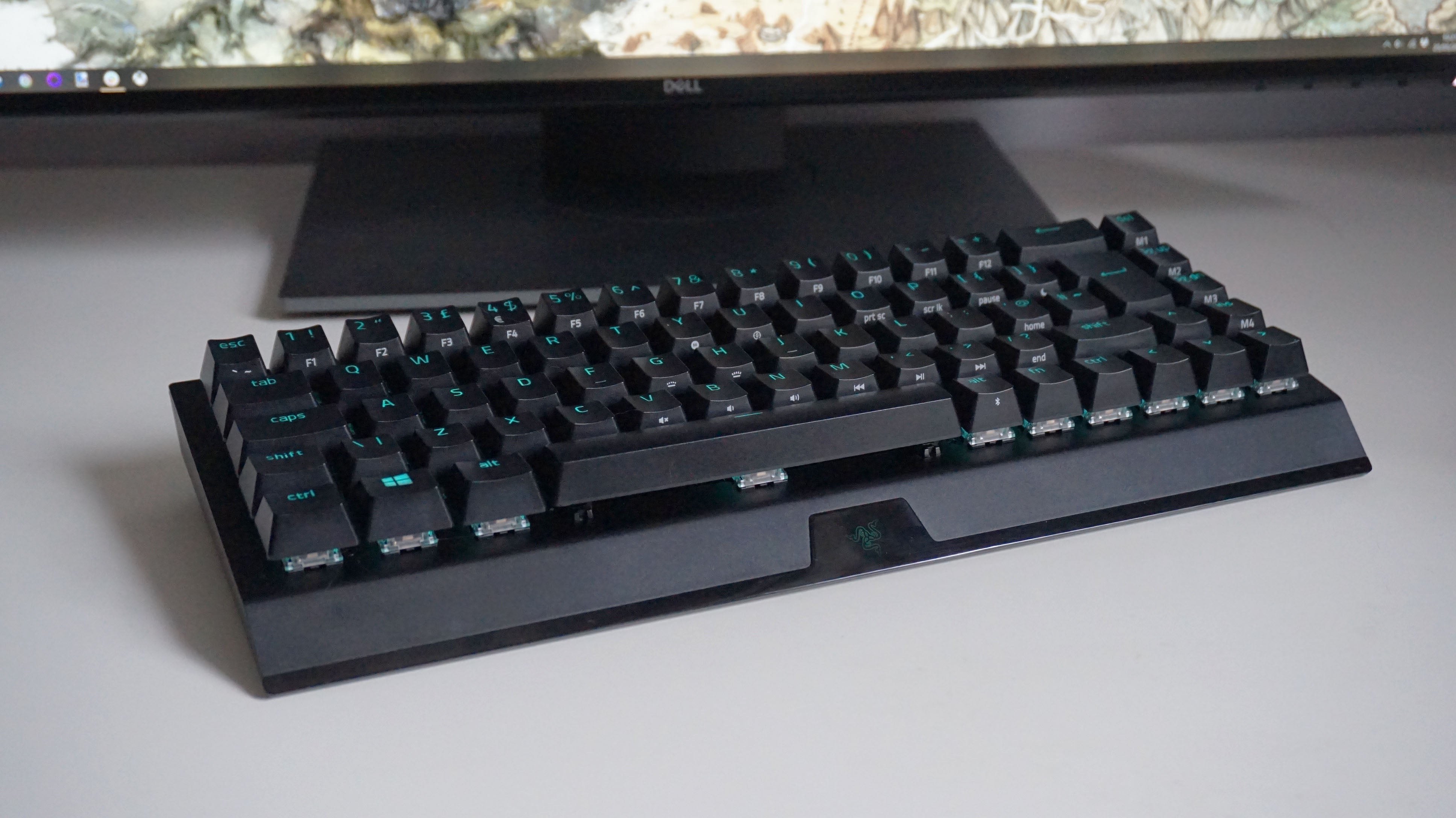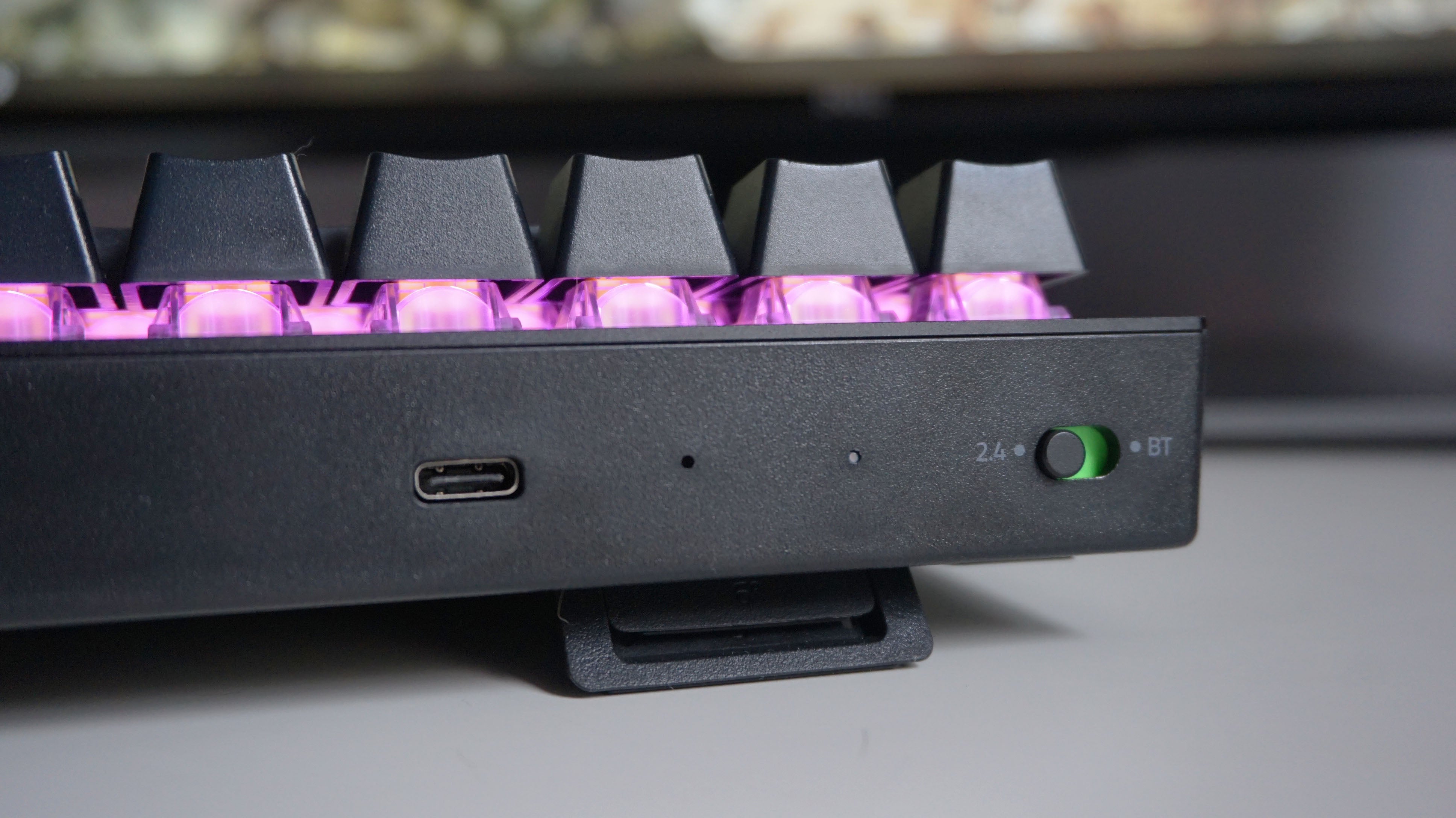Despite its smaller size, the Blackwidow V3 Mini Hyperspeed doesn’t come cheap, with its launch price starting at £180 / $180. That’s another £40 / $40 on top of the full-sized Blackwidow V3, which also comes with a lovely plush wrist rest for that extra layer of comfort. Still, as with all small things in tech, you’re paying for that compact convenience.
Provided you can stomach dropping that much cash on a wireless gaming keyboard, though, the Blackwidow V3 Mini Hyperspeed has plenty to recommend it. The linear yellow switches on my review model provided plenty of tactile feedback during my testing, making them very comfy for typing at work and playing games in the evening. They’re not too noisy, either, producing a low-level clack that would probably still be quite irritating for people in the same room as you, but not so bad that you’ll get complaints from family members in other parts of your house.
The keyboard is well laid out, too. It took me no time at all to get up to my regular typing speed, as every key was exactly where my fingers expected it to be. The gentle, sloping gradient of both its aluminium chassis and doubleshot ABS keycaps meant I also never tripped up on them when reaching for keys further up, and I was still able to see their secondary function labels on their front sides. Even better, when you go to hold down the Fn key, the Blackwidow V3 Mini Hyperspeed’s RGB backlight switches to a solid white backlight, highlighting the specific keys that have secondary functions attached to them. This makes it super easy to see at a glance exactly what key you’re actually looking for, whether you just want to change the volume or activate its special gaming mode to lock the Windows key and disable Alt-Tab and Alt-F4 functions.
Like all Razer keyboards, every key can be programmed to your liking using Razer’s free Synapse software, allowing you to rebind all keyboard functions, as well as use them for mouse and multimedia controls, launching programs, websites and Windows shortcuts, or writing text. However, much like the equally compact Fnatic Streak 65, Razer have also used the extra space on the far right hand side of the keyboard to include four extra navigation keys that double up as programmable macro keys. These can be recorded with or without Razer’s Synapse software, although it’s a heck of a lot easier to record them with said software, rather than trying to remember the exact combination of keys you need to make them record successfully.
You can also use Razer’s Synapse to adjust the brightness of the keyboard’s RGB backlight, as well as adjust when the lighting turns off to save battery. This can be when your PC’s display turns off or after your PC’s been idle for a set number of minutes. There’s also a power saving mode that will turn the keyboard off after it’s been inactive for at least 15 minutes, although you can set this up to a maximum of 60 minutes of inactivity if you prefer.
I’d strongly recommend employing the latter if you’re using the V3 Blackwidow Hyperspeed over 2.4GHz wireless and like having your RGB backlight flashing away, as this thing eats battery like nobody’s business. With its RGB brightness set to 100%, I maybe managed just over two days of solid use from the V3 Mini Hyperspeed, which was short enough to make me groan, “Not again!?” whenever I saw one of Synapse’s battery notifications pop up on my PC. Annoyingly, Razer have put its battery indicator LED on the back of the keyboard next to the Bluetooth / 2.4GHz wireless switch, making it difficult to tell in advance when it actually needs charging. I don’t know about you, but I don’t regularly turn my keyboard round to check how its battery’s doing once I’ve finished work for the day, and it often felt like I’d only just finished charging it before it was out of juice again.
In its defence, its bundled USB-C to USB Type-A cable means it only takes around two hours to hit full charge again, and you can carry on using it while it’s wired into your PC. You can also use the same USB dongle as Razer’s other Hyperspeed devices, such as their recently-released Orochi V2 mouse, to save on USB ports when you’re connected over 2.4GHz wireless. You’ll also get more out of it by lowering the RGB brightness, too, but you’re probably still looking at charging it at least once a week if you use it all day everyday like I do.
Indeed, if you’re going to be using it for both work and play, then you’ll probably need to get into the habit of switching over to its Bluetooth mode when you’re not playing games, as this will make the Blackwidow V3 Mini Hyperspeed last a heck of a lot longer. Razer claims you’ll get up to 200 hours of use over Bluetooth, which is probably a much more sensible way of using the keyboard when you don’t need its super fast, low latency Hyperspeed response times for playing games. It’s not exactly ideal - I, for one, am far too lazy to keep remembering to switch modes every time I want to play a game - but at least you’ve got the option.
It’s a shame its 2.4GHz wireless battery life isn’t better, but when there are still so few 65% wireless gaming keyboards out there, it’s hard to tell whether this is just an inherent flaw of its small form factor, or whether this particular keyboard is simply not very good at holding its battery. Part of me suspects the former, as even my current favourite wireless gaming keyboard, the full-sized Logitech G915 Lightspeed Wireless, is only rated for 30 hours of battery life at 100% RGB brightness, which roughly works out to just under four days of all-day use - or less if you’re also using it to play games in the evening.
Still, battery life issues aside, I’m glad there are more compact wireless keyboards like the Razer Blackwidow V3 Mini Hyperspeed starting to get made, even if they are on the rather expensive side. I’m a big fan of tenkeyless and 65% keyboards (never 60%, because I simply cannot do without my beloved arrow keys), but so far there have been precious few wireless ones apart from the Logitech G915 TKL Lightspeed, which is even more eye-wateringly expensive at £200 / $200.
In truth, I reckon it’s probably worth shelling out the extra twenty quid in all honesty, as that one’s rated for 40 hours battery life (somehow, despite being smaller than the regular G915) and uses the same lovely low-profile keys and chassis as the regular G915. It doesn’t have the added Bluetooth support, but then again, I’d probably rather spend that extra £20 just so I didn’t have to keep flipping a switch everyday. You may feel differently, of course, in which case the Razer Blackwidow V3 Mini Hyperspeed is almost certainly going to be the wireless 65% keyboard you’ve been looking for.


